2016 HONDA CIVIC COUPE brake sensor
[x] Cancel search: brake sensorPage 167 of 585
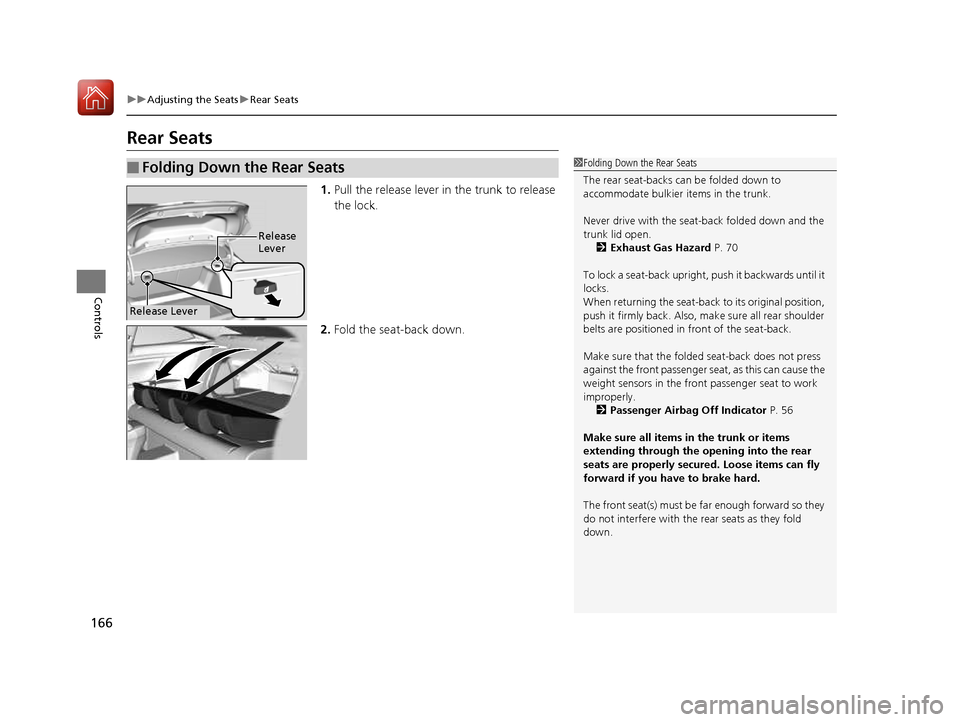
166
uuAdjusting the SeatsuRear Seats
Controls
Rear Seats1.Pull the release lever in the trunk to release
the lock.
2. Fold the seat-back down.
■Folding Down the Rear Seats1Folding Down the Rear Seats
The rear seat-backs can be folded down to
accommodate bulkier items in the trunk.
Never drive with the seat-back folded down and the trunk lid open.
2 Exhaust Gas Hazard P. 70
To lock a seat-back upright, push it backwards until it
locks.
When returning the seat-back to its original position,
push it firmly back. Also, m ake sure all rear shoulder
belts are positioned in front of the seat-back.
Make sure that the folded seat-back does not press
against the front passenger se at, as this can cause the
weight sensors in the front passenger seat to work
improperly. 2 Passenger Airbag Off Indicator P. 56
Make sure all items in the trunk or items
extending through the opening into the rear
seats are properly secured. Loose items can fly
forward if you have to brake hard.
The front seat(s) must be far enough forward so they
do not interfere with the rear seats as they fold down.
Release Lever
Release Lever
16 CIVIC 2D HC2 (0A 01 0C)-31TBG6000.book 166 ページ >0>.>/6年>0月>/>0日 金曜日 午後4時>/6分
Page 380 of 585
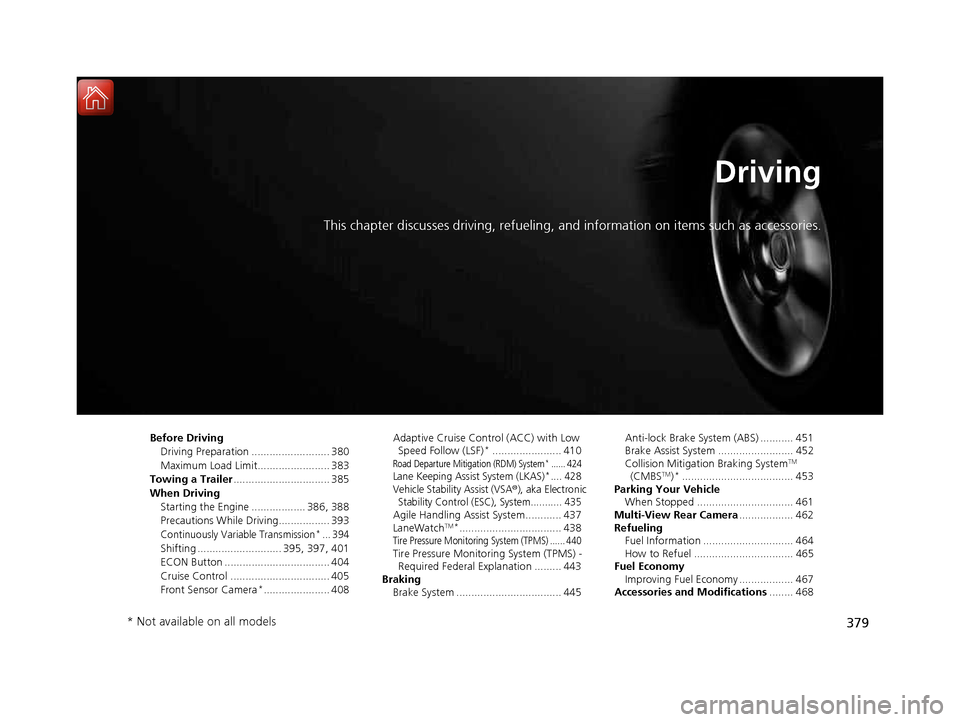
379
Driving
This chapter discusses driving, refueling, and information on items such as accessories.
Before Driving
Driving Preparation .......................... 380
Maximum Load Limit........................ 383
Towing a Trailer ................................ 385
When Driving Starting the Engine .................. 386, 388
Precautions While Driving................. 393
Continuously Variable Transmission*... 394
Shifting ............................ 395, 397, 401
ECON Button ................................... 404
Cruise Control ................................. 405Front Sensor Camera *
...................... 408 Adaptive Cruise Control (ACC) with Low
Speed Follow (LSF) *
....................... 410
Road Departure Mitigation (RDM) System*...... 424Lane Keeping Assist System (LKAS)*.... 428
Vehicle Stabilit y Assist (VSA®), aka Electronic
Stability Control (ESC), System........... 435
Agile Handling Assist System............ 437
LaneWatch TM
*
.................................. 438
Tire Pressure Monitoring System (TPMS) ...... 440Tire Pressure Monitoring System (TPMS) -
Required Federal Explanation ......... 443
Braking
Brake System ................................... 445 Anti-lock Brake System (ABS) ........... 451
Brake Assist System ......................... 452
Collision Mitigation Braking System
TM
(CMBS TM
)*
..................................... 453
Parking Your Vehicle When Stopped ................................ 461
Multi-View Rear Camera .................. 462
Refueling
Fuel Information .............................. 464
How to Refuel ................................. 465
Fuel Economy
Improving Fuel Economy .................. 467
Accessories and Modifications ........ 468
* Not available on all models
16 CIVIC 2D HC2 (0A 01 0C)-31TBG6000.book 379 ページ >0>.>/6年>0月>/>0日 金曜日 午後4時>/6分
Page 411 of 585
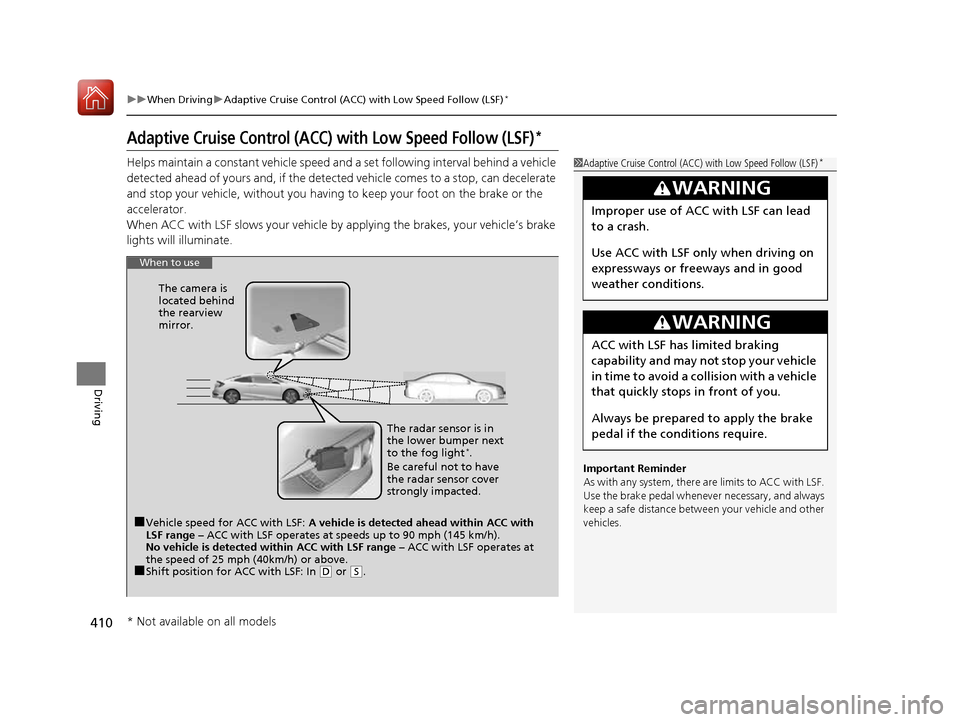
410
uuWhen DrivinguAdaptive Cruise Control (ACC) with Low Speed Follow (LSF)*
Driving
Adaptive Cruise Control (ACC) with Low Speed Follow (LSF)*
Helps maintain a constant vehicle speed an
d a set following interval behind a vehicle
detected ahead of yours and, if the detect ed vehicle comes to a stop, can decelerate
and stop your vehicle, without you having to keep your foot on the brake or the accelerator.When ACC with LSF slows your vehicle by applying the brakes, your vehicle’s brake
lights will illuminate.1Adaptive Cruise Control (ACC) with Low Speed Follow (LSF)*
Important Reminder
As with any system, there are limits to ACC with LSF.
Use the brake pedal whenever necessary, and always
keep a safe distance betw een your vehicle and other
vehicles.
3WARNING
Improper use of ACC with LSF can lead
to a crash.
Use ACC with LSF only when driving on
expressways or freeways and in good
weather conditions.
3WARNING
ACC with LSF has limited braking
capability and may not stop your vehicle
in time to avoid a co llision with a vehicle
that quickly stops in front of you.
Always be prepared to apply the brake
pedal if the cond itions require.
When to use
■Vehicle speed for ACC with LSF: A vehicle is detected ahead within ACC with
LSF range – ACC with LSF operates at speeds up to 90 mph (145 km/h).
No vehicle is detected within ACC with LSF range – ACC with LSF operates at
the speed of 25 mph (40km/h) or above.
■ Shift position for ACC with LSF: In
(D or (S. The radar sensor is in
the lower bumper next to the fog light
*
.
Be careful not to have
the radar sensor cover
strongly impacted.
The camera is
located behind
the rearview mirror.
* Not available on all models
16 CIVIC 2D HC2 (0A 01 0C)-31TBG6000.book 410 ページ >0>.>/6年>0月>/>0日
金曜日 午後4時>/6分
Page 416 of 585
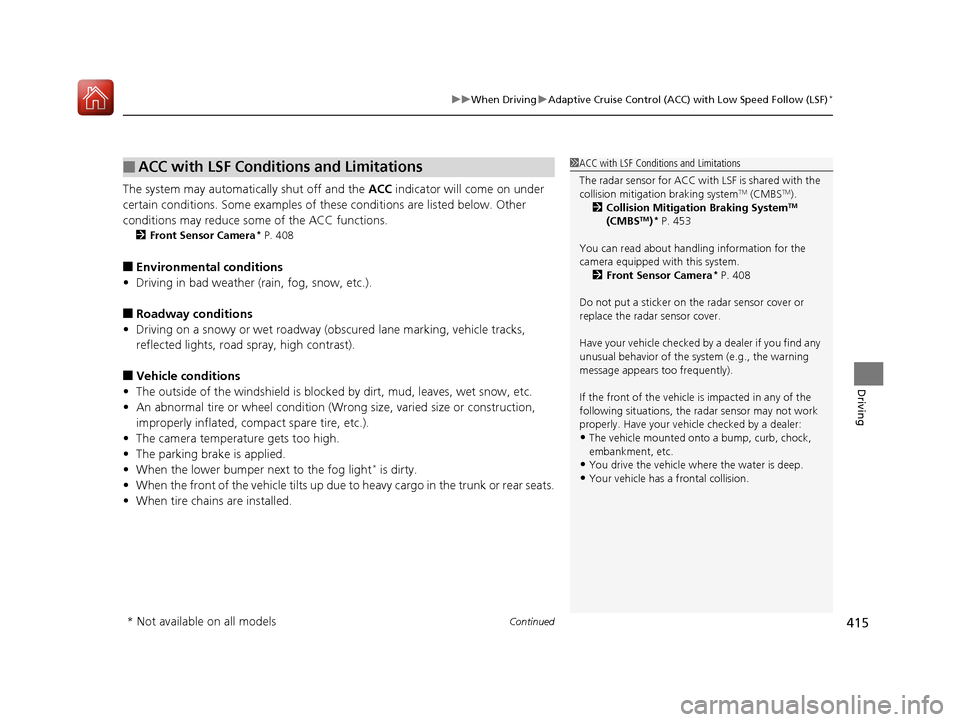
Continued415
uuWhen DrivinguAdaptive Cruise Control (ACC) with Low Speed Follow (LSF)*
Driving
The system may automatically shut off and the
ACC indicator will come on under
certain conditions. Some exam ples of these conditions are listed below. Other
conditions may reduce some of the ACC functions. 2 Front Sensor Camera *
P. 408
■ Environmental conditions
• Driving in bad weather (rain, fog, snow, etc.).
■ Roadway conditions
• Driving on a snowy or wet roadway (obs cured lane marking, vehicle tracks,
reflected lights, road spray, high contrast).
■ Vehicle conditions
• The outside of the windshield is blocked by dirt, mud, leaves, wet snow, etc.
• An abnormal tire or wheel condition (Wrong size, varied size or construction,
improperly inflated, co mpact spare tire, etc.).
• The camera temperature gets too high.
• The parking brake is applied.
• When the lower bumper next to the fog light *
is dirty.
• When the front of the vehicle tilts up due to heavy cargo in the trunk or rear seats.
• When tire chains are installed.
■ACC with LSF Conditions and Limitations1ACC with LSF Conditions and Limitations
The radar sensor for ACC with LSF is shared with the
collision mitigation braking system TM
(CMBS TM
).
2 Collision Mitigation Braking System TM
(CMBS TM
)*
P. 453
You can read about handling information for the
camera equipped with this system. 2 Front Sensor Camera *
P. 408
Do not put a sticker on the radar sensor cover or
replace the radar sensor cover.
Have your vehicle checked by a dealer if you find any unusual behavior of the sy stem (e.g., the warning
message appears too frequently). If the front of the vehicle is impacted in any of the
following situations, the ra dar sensor may not work
properly. Have your vehi cle checked by a dealer:
• The vehicle mounted onto a bump, curb, chock, embankment, etc.
• You drive the vehicle where the water is deep.
• Your vehicle has a frontal collision.
* Not available on all models
16 CIVIC 2D HC2 (0A 01 0C)-31TBG6000.book 415 ページ >0>.>/6年>0月>/>0日 金曜日 午後4時>/6分
Page 417 of 585
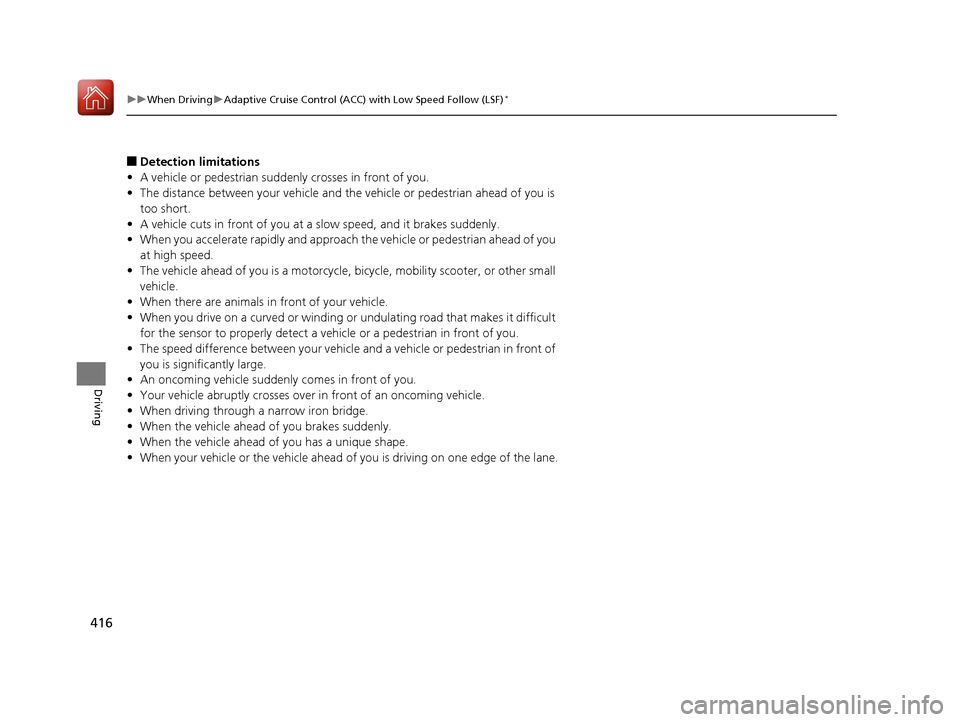
416
uuWhen DrivinguAdaptive Cruise Control (ACC) with Low Speed Follow (LSF)*
Driving
■
Detection limitations
• A vehicle or pedestrian suddenly crosses in front of you.
• The distance between your vehicle and the vehicle or pedestrian ahead of you is
too short.
• A vehicle cuts in front of you at a slow speed, and it brakes suddenly.
• When you accelerate rapidly and approach the vehicle or pedestrian ahead of you
at high speed.
• The vehicle ahead of you is a motorcycle, bicycle, mobility scooter, or other small
vehicle.
• When there are animals in front of your vehicle.
• When you drive on a curved or winding or undulating road that makes it difficult
for the sensor to properly detect a vehicle or a pedestrian in front of you.
• The speed difference between your vehicle an d a vehicle or pedestrian in front of
you is significantly large.
• An oncoming vehicle suddenly comes in front of you.
• Your vehicle abruptly crosses over in front of an oncoming vehicle.
• When driving through a narrow iron bridge.
• When the vehicle ahead of you brakes suddenly.
• When the vehicle ahead of you has a unique shape.
• When your vehicle or the vehicle ahead of you is driving on one edge of the lane.
16 CIVIC 2D HC2 (0A 01 0C)-31TBG6000.book 416 ページ >0>.>/6年>0月>/>0日 金曜日 午後4時>/6分
Page 422 of 585

Continued421
uuWhen DrivinguAdaptive Cruise Control (ACC) with Low Speed Follow (LSF)*
Driving
■
Automatic ca ncellation
The beeper sounds and a message appears on the driver information interface when
ACC with LSF is automatically canceled. Any of these conditions may cause the ACC
with LSF to automatically cancel: • Bad weather (rain, fog, snow, etc.)
• When the radar sensor in the lower bumper next to the fog light *
gets dirty.
• The vehicle ahead of yo u cannot be detected.
• An abnormal tire condition is detected, or the tires are skidding.
• Driving on a mountainous road, or driving off road for extended periods.
• Abrupt steering wheel movement.
• When the ABS, VSA ® or CMBS TM
is activated.
• When the ABS or VSA ® system indicator comes on.
• When the vehicle is stopped on a very steep slope.
• When you manually apply the parking brake.
• When the detected vehicle within the AC C with LSF range is too close to your
vehicle.
• The camera behind the rearview mirror, or the area around the camera, including
the windshield, gets dirty.
The ACC with LSF automatic cancellation ca n be also triggered by the following
causes. In these cases, the parking brake will be automatically applied.
• The driver’s seat belt is unfastene d when the vehicle is stationary.
• The vehicle stops for more than 10 minutes.
• The engine is turned off.1Automatic cancellation
Even though ACC with LSF has been automatically
canceled, you can still resu me the prior set speed.
Wait until the condition that caused ACC with LSF to
cancel improves, then press the –/SET button.
* Not available on all models
16 CIVIC 2D HC2 (0A 01 0C)-31TBG6000.book 421 ページ >0>.>/6年>0月>/>0日 金曜日 午後4時>/6分
Page 454 of 585
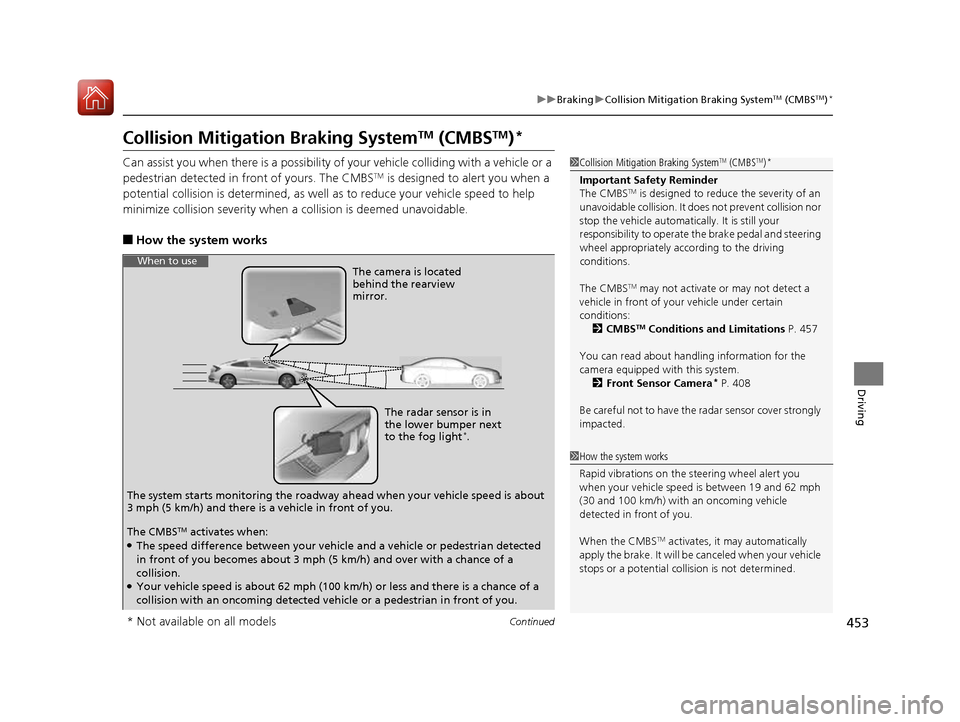
453
uuBrakinguCollision Mitigation Braking SystemTM
(CMBS TM
)*
Continued
Driving
Collision Mitigation Braking System TM
(CMBS TM
)*
Can assist you when there is a possibility of your vehicle colliding with a vehicle or a
pedestrian detected in front of yours. The CMBS TM
is designed to alert you when a
potential collision is determined, as well as to reduce your vehicle speed to help
minimize collision severity when a collision is deemed unavoidable.
■ How the system works
1Collision Mitigation Braking System TM
(CMBS TM
)*
Important Safety Reminder
The CMBS TM
is designed to reduce the severity of an
unavoidable collision. It doe s not prevent collision nor
stop the vehicle automatically. It is still your
responsibility to operate the brake pedal and steering
wheel appropriately acco rding to the driving
conditions.
The CMBS TM
may not activate or may not detect a
vehicle in front of y our vehicle under certain
conditions:
2 CMBS TM
Conditions and Limitations P. 457
You can read about handling information for the
camera equipped with this system. 2 Front Sensor Camera *
P. 408
Be careful not to have the radar sensor cover strongly
impacted.
1How the system works
Rapid vibrations on the steering wheel alert you
when your vehicle speed is between 19 and 62 mph
(30 and 100 km/h) with an oncoming vehicle
detected in front of you.
When the CMBS TM
activates, it may automatically
apply the brake. It will be canceled when your vehicle
stops or a potential coll ision is not determined.
The radar sensor is in
the lower bumper next
to the fog light*
.
The camera is located
behind the rearview mirror.
The system starts monitoring the roadway ah ead when your vehicle speed is about
3 mph (5 km/h) and there is a vehicle in front of you.
When to use
The CMBS TM
activates when:
● The speed difference between your vehicle and a vehicle or pedestrian detected
in front of you becomes about 3 mph (5 km/h) and over with a chance of a
collision.
● Your vehicle speed is about 62 mph (100 km/h) or less and there is a chance of a
collision with an oncoming detected ve hicle or a pedestrian in front of you.
* Not available on all models
16 CIVIC 2D HC2 (0A 01 0C)-31TBG6000.book 453 ページ >0>.>/6年>0月>/>0日 金曜日 午後4時>/6分
Page 459 of 585
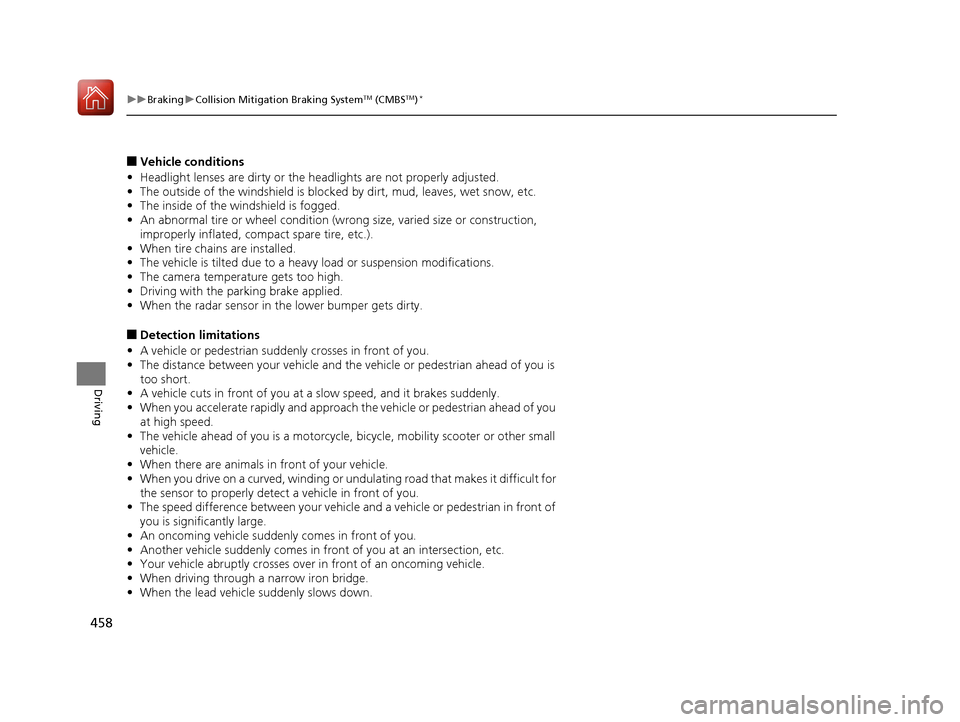
458
uuBrakinguCollision Mitigation Braking SystemTM
(CMBS TM
)*
Driving
■
Vehicle conditions
• Headlight lenses are dirty or the headlights are not properly adjusted.
• The outside of the windshie ld is blocked by dirt, mud, leaves, wet snow, etc.
• The inside of the windshield is fogged.
• An abnormal tire or wheel condition (wrong size, varied size or construction,
improperly inflated, comp act spare tire, etc.).
• When tire chains are installed.
• The vehicle is tilted due to a heav y load or suspension modifications.
• The camera temperature gets too high.
• Driving with the parking brake applied.
• When the radar sensor in the lower bumper gets dirty.
■ Detection limitations
• A vehicle or pedestrian suddenly crosses in front of you.
• The distance between your vehicle and the vehicle or pedestrian ahead of you is
too short.
• A vehicle cuts in front of you at a slow speed, and it brakes suddenly.
• When you accelerate rapidly and approach the vehicle or pedestrian ahead of you
at high speed.
• The vehicle ahead of you is a motorcycle, bicycle, mobility scooter or other small
vehicle.
• When there are animals in front of your vehicle.
• When you drive on a curved, wi nding or undulating road that makes it difficult for
the sensor to properly detect a vehicle in front of you.
• The speed difference between your vehicle an d a vehicle or pedestrian in front of
you is significantly large.
• An oncoming vehicle suddenly comes in front of you.
• Another vehicle suddenly comes in front of you at an intersection, etc.
• Your vehicle abruptly crosses over in front of an oncoming vehicle.
• When driving through a narrow iron bridge.
• When the lead vehicle suddenly slows down.
16 CIVIC 2D HC2 (0A 01 0C)-31TBG6000.book 458 ページ >0>.>/6年>0月>/>0日 金曜日 午後4時>/6分